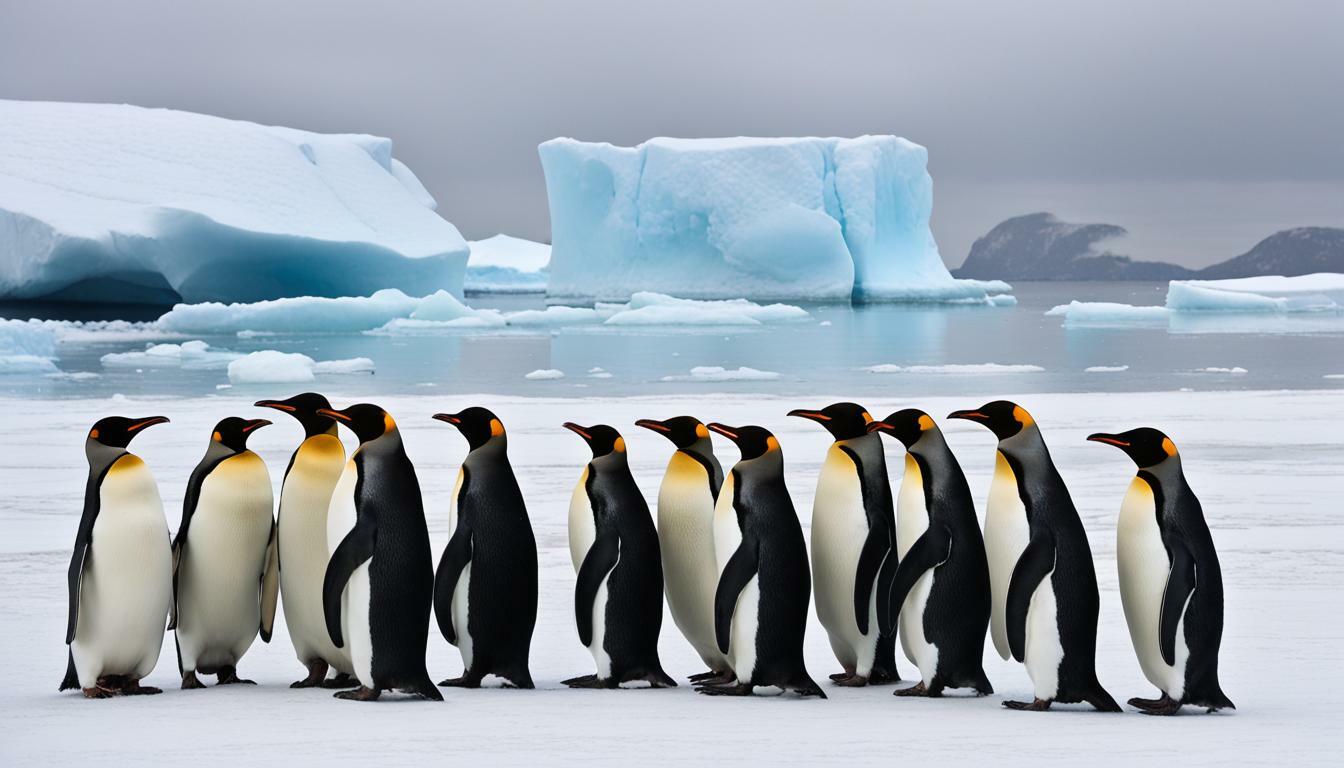If you’ve ever seen a picture of a penguin, you might think that they are tailless birds. After all, their rounded, plump bodies don’t seem to have any visible tails sticking out the back. But is that really the case? Do penguins have tails, or are they truly tailless creatures?
In this article, we’ll explore the truth behind penguin anatomy and answer the question once and for all. Along the way, you’ll learn about the different physical features of penguins, their evolutionary history, and the fascinating adaptations that help them survive in some of the harshest environments on Earth.
Key Takeaways:
- Penguins are often thought of as tailless birds, but this is a common misconception.
- Throughout this article, we’ll explore the anatomy of penguins, their evolutionary history, and whether or not they actually have tails.
- By the end of this article, you’ll have a better understanding of the unique and fascinating creatures we know as penguins.
Penguin Anatomy: Exploring the Physical Features
Penguins are fascinating creatures with unique physical features that help them survive in their harsh environments. Let’s take a closer look at their anatomy and characteristics.
Firstly, penguins are flightless birds with streamlined bodies and strong, paddle-like flippers that allow them to swim efficiently. Their wings have evolved into flippers, while their bones have become solid to provide greater stability while swimming.
Another characteristic feature of penguins is their beaks, which vary in size and shape depending on their diet. Some penguins have long, narrow beaks for catching fish, while others have short, blunt beaks for feeding on krill. Their beaks are also sensitive to touch, allowing them to identify objects in murky water.
One of the most interesting aspects of penguin anatomy is their feathers. Penguins have a layer of short, stiff feathers that provide insulation and a waterproof coating. They also have long, thin feathers called “filoplumes” that help them sense water pressure, enabling them to navigate and detect prey while swimming.
But what about their tails? Contrary to popular belief, penguins do have tails. However, their tails are short and wedge-shaped, consisting of stiff, fused feathers that provide balance while waddling on land and swimming in water.
There are 18 species of penguins, each with their own distinct physical characteristics. For example, the emperor penguin is the largest species, standing at over 4 feet tall, while the little blue penguin is the smallest, averaging only 16 inches in height.
In conclusion, penguins have unique physical features that allow them to thrive in their marine environments. Their wings, beaks, flippers, and feathers have all evolved to meet their specific needs. And while they may not have long, flowing tails like some bird species, they do have short, wedge-shaped tails that serve an important purpose in their daily lives.
Penguin Evolution: Tracing the Origins
Millions of years ago, penguins evolved from flying birds into skilled swimmers. Their ancestors were likely seabirds that gradually adapted to life in the water, losing the ability to fly and developing a more streamlined physique for swimming.
Today, there are 18 known species of penguins, all of which reside in the southern hemisphere. Each species has unique characteristics that have evolved over time to suit their respective environments, from the Emperor Penguin, which can survive in sub-zero temperatures, to the Galapagos Penguin, which can withstand the heat of the equator.
While penguins are often associated with their distinctive tuxedo-like appearance, their anatomy is also particularly adapted for marine life. Their wings have evolved into flippers, enabling them to swim rapidly through water, while their beaks are streamlined for catching fish.
Despite the common myth that penguins do not have tails, they actually do have them, albeit in a slightly different form. Unlike many birds, penguins have short, stiff tail feathers that are fused together, helping them to maintain balance and maneuver underwater.
Scientists have studied the evolution of penguins extensively, piecing together the history of the species over millions of years. While there is still much to learn about these fascinating creatures, one thing is certain: their evolutionary journey has led to the development of unique physical characteristics and abilities that make them a wonder to behold.
Debunking the Tail Myth: Do Penguins Have Tails?
There is a common misconception that penguins are tailless birds. However, this is simply not true. Penguins do have tails, but they are not the long, protruding tails that you might imagine. Instead, their tails are short, stiff, and wedge-shaped, consisting of several fused vertebrae covered in feathers.
The primary function of a penguin’s tail is to help with balance and stability while swimming. It also serves as a rudder, enabling the penguin to make quick and precise turns underwater. While some penguin species have longer tails than others, all penguins do have this important anatomical feature.
So why do so many people think that penguins are tailless? One reason is that penguins have very short legs, which are hidden beneath their plump bodies. This can make it difficult to see their tails, especially when they are waddling along on land. Additionally, in cartoons and other media, penguins are often depicted without tails, further perpetuating the misconception.
However, scientific evidence confirms that penguins do indeed have tails. In fact, the presence of a tail is one of the characteristics that distinguishes penguins from other types of flightless birds, such as ostriches and emus.
In conclusion, penguins do have tails, despite the common misconception that they are tailless birds. Their tails are short, stiff, and wedge-shaped, providing balance and stability while swimming. So the next time you see a penguin, take a closer look and you’ll be able to spot its tail!
Conclusion
In conclusion, we can confirm that penguins do indeed have tails! While they may not be as pronounced as the tails of other birds, penguins have short, stumpy tail feathers that are critical for balance and stability on land and in water.
Throughout the article, we’ve explored the fascinating anatomy and evolutionary history of these incredible creatures. From their unique physical features to their gradual adaptation to marine life over millions of years, penguins are truly a wonder of nature.
So, the next time you come across a penguin, remember not to be fooled by their seemingly tailless appearance. These remarkable birds have adapted to their environment in extraordinary ways, and their tails are just one piece of the puzzle.
Do Birds, Including Penguins, Have Opposable Thumbs?
Birds and opposable thumbs do not go hand in hand. While many birds boast feet with talons, capable of gripping objects, they lack true opposable thumbs. Penguins, being birds too, do not possess this handy trait. However, their flippers adeptly mobilize their bodies in water, aiding their survival in the Antarctic environment.
FAQ
Q: Do penguins have tails?
A: Yes, penguins do have tails. Contrary to a common misconception, penguins are not tailless.
Q: What is the purpose of a penguin’s tail?
A: A penguin’s tail helps with balance and steering while swimming. It aids in their agile movements underwater.
Q: Are all penguin tails the same?
A: No, different penguin species have tails of varying lengths and shapes. The tail feathers can differ in appearance and size.
Q: Can penguins fly with their tails?
A: Penguins are flightless birds, and their tails are not used for flying. Instead, they rely on their flippers for propulsion in the water.
Q: How does a penguin’s tail compare to other bird species?
A: Penguin tails are relatively short compared to many other bird species. Their tail feathers are stiff and broad, aiding in swimming rather than flight.
Q: Are penguin tails visible when they are out of the water?
A: Penguin tails are not very visible when they are on land, as they are covered by their feathers and tucked beneath their bodies.
Q: Are there any unique facts about penguin tails?
A: Some penguin species have tails that are wedge-shaped, which helps them dive and maneuver through the water with precision.
Q: Do baby penguins have tails?
A: Yes, baby penguins are born with tails. They develop and grow along with the rest of their body as they mature.
Q: Can penguin tails be identified by their color?
A: The color of a penguin’s tail feathers generally matches the coloration of their overall plumage. Different species have distinct color patterns.











